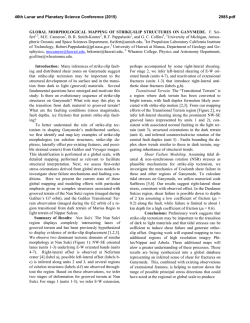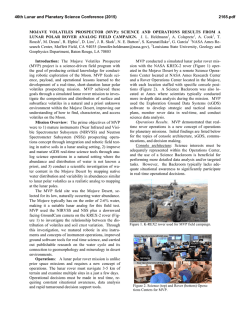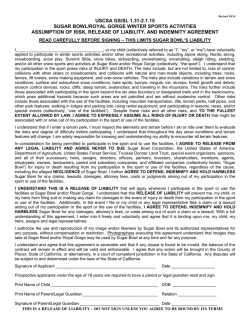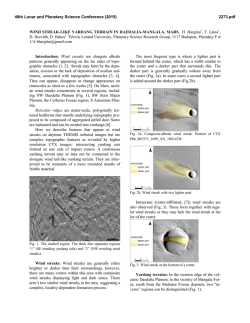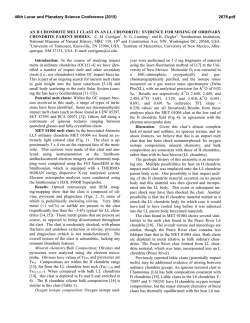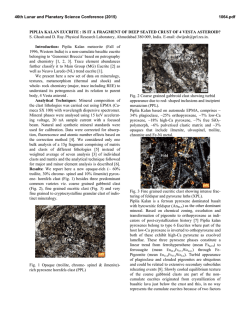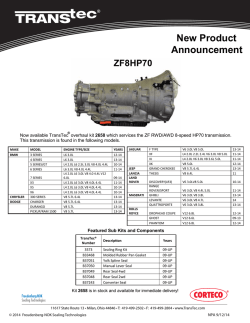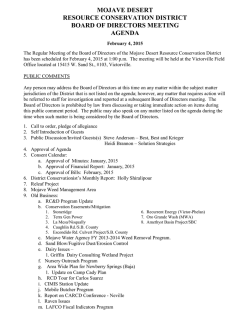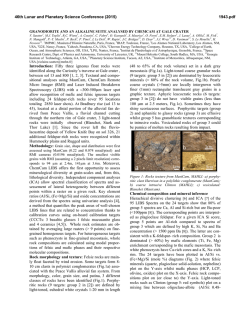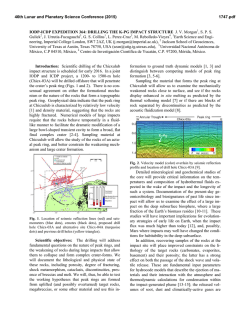
classifying planetary surfaces with results from texturecam
46th Lunar and Planetary Science Conference (2015) 2239.pdf CLASSIFYING PLANETARY SURFACES WITH RESULTS FROM TEXTURECAM PROCESSING WITH THE MOJAVE VOLATILES PROSPECTOR (MVP) ROVER MISSION. N. E. Button1, J. R. Skok1, J. L. Heldmann2, D. Thompson3, K. Ortega3, R. Francis4, M. Deans2, D. Lees5, G. Garcia2, S. Karunatillake1 1 Louisiana State University, Department of Geology and Geophysics, Baton Rouge, LA 70803 ([email protected]); 2 NASA Ames Research Center, Mountain View, CA 94035; 3Jet Propulsion Laboratory, California Institute of Technology, Pasadena, CA 91109; 4Centre for Planetary Science and Exploration, University of Western Ontario, London, Canada; 5Carnegie Mellon University, Silicon Valley Campus, NASA Research Park, Moffett Field, CA Introduction: The Mojave Volatiles Prospector (MVP) rover mission was a mission simulation for a real-time lunar polar Resource Prospector (RP) rover mission as well as an opportunity to study the Mojave Desert to understand the H2O emplacement, retention, and distribution, which expands on the work of Wood et al. [1, 2]. The mission simulation took place on October 20-24, 2014 with the rover located in the Mojave Desert and the science team located at NASA Ames to best simulate the reliance on rover imagery during an extraterrestrial mission. The rover instrument suite included a downward-pointing visible camera (Groundcam), Hazard Cameras, Near Infrared and Visible Spectrometer Subsystem (NIRVSS), and Neutron Spectrometer Subsystem (NSS). Because the science team was located remotely, the cameras provided the only real time visual observation of the field site for use during operation, guidance, hazard avoidance, and target selection. Groundcam recorded observations perpendicular to the ground, providing a 1m x 1m image. Understanding the surface terrain is critical for understanding the subsurface distribution of H2O eolian processes, and weathering processes. Given the large number of images (4 per minute), we used an automatic pixel classification method, known as TextureCam, to categorize the surface terrain in each of the images collected by the Groundcam [3]. The underlying TextureCam algorithm served as the primary automation tool, employing a version of random forest classification described in prior work [4]. Data and Methods: We use TextureCam to identify the surface terrain in each of the Groundcam images, which ultimately leads to terrain classification of the field site traversed by the rover. The first step in TextureCam processing is to manually color-code a subset of images (typically fewer than 5) using a drawing program such as the GNU Image Manipulation Program (GIMP), as shown in Figure 1. We identify each terrain category by a different color. The types of terrain were determined by visual, qualitative inspection of the Groundcam imagery at the beginning of the mission session. We initially identified four terrain types as: 1. Low albedo desert pavement, rocks, >65% areal clast cover, and flat terrain; 2. High albedo wash deposits with few rocks and small clast sizes; 3. Rocky with larger rocks, scattered rocks within washes; 4. High albedo patch with similar rock distributions as Terrain 1, embedded within Terrain 1. After color-coding representative images of each terrain type, we train the pattern recognition system to recognize these classes, storing the resulting model with a “random forest file” [3]. The random forest file can then be applied to any Groundcam image to produce an automatically color-coded result, as shown in Figure 1c. This corresponds to the original color classification during the manual calibration stage. In order to facilitate a synoptic understanding of the terrain across the field site, the mission operations system summarized these images in an overhead map; it colored each location by the areally dominant terrain type in Google Earth using GPS data associated with the Groundcam image. The terrain classification was refined during the mission session to a clast size classification. The three clast size classifications are soil and fine pebbles, small gravel, and cobbles. However, with this classification system, terrain types are not identified because some types of terrain may have a combination of clast sizes. This classification could be used to develop a terrain classification and may even produce a similar terrain classification to the initial classification developed at the start of the mission session. Lastly, samples were collected from the field site to groundtruth the mission data. Ther terrain types were manually mapped and were developed with more detailed descriptions of the initial terrain classification. In addition, we collected samples for cumulative areal clast size distributions with the intent of applying advanced segmentation developed by [5]. The fieldwork allowed us to understand the limitations of relying solely on rover imagery data. Given the physical inaccessibility of field sites in future extraterrestrial missions, it is imperative to understand the limitations of the imagery data, in order to ensure correct identification of surface terrain using TextureCam. Results and Discussion: As this was the first attempt to use real time TextureCam processing to guide other science results, we encountered several difficulties with producing a random forest file that would correctly identify all the surface terrains traversed. One complication was highly variable illumination, in which portions of the terrain were directly sunlit, indirectly illuminated, or fully shadowed. 46th Lunar and Planetary Science Conference (2015) Figure 1a) Groundcam image (GroundCam01414009795.234124_gr aylzw.tiff) representing Terrain Type 1 (low albedo desert pavement, rocks, >65% clast cover, flat terrain). b) Manual coloring of Groundcam image (GroundCam01414009795.234124_gr aylzw.tiff). The color blue is used to represent Terrain Type 1. c) Automated coloring of Groundcam image (GroundCam01414009795.234124_gr aylzw.tiff) produced from TextureCam. The majority of Terrain Type 1 was correctly identified (as represented by the blue) through TextureCam processing, but some areas were misidentified as Terrain Types 2 and 3 (red and green, respectively). Figure 2. Manual coloring of Terrain Type 2 (high albedo wash deposits, few rocks, small particle sizes), as represented by red (left) and Terrain Type 3 (rocky, larger rocks, scattered rocks within washes), as represented by green (right). These differences dramatically affected focus and apparent texture with a signal that was far larger than the geologic distinctions we aimed to retrieve. The illumination changed slowly over time as the rover traversed and changed directions, but these changes were often independent of geologic content creating a strong confounding effect. This could be partially remedied through standard preprocessing techniques and heuristic filtering. Nevertheless, uniform illumination will be an important consideration for future attempts to derive geologic content automatically from downwardpointing images. Color or spectral information could also be incorporated in the classification, and might be more robust than apparent texture to variability in the magnitude and directionality of illumination. 2239.pdf Visual observation of the Groundcam images to identify each new traversed was used as verification for the TextureCam processing. However, live processing will be essential for future extraterrestrial missions. We are able to use the collected data to conduct post-processing to develop a working TextureCam process. With successful post-processing, we will be able to use TextureCam in future missions, specifically the Resource Prospector (RP), a future lunar mission. The fieldwork following the mission session also demonstrated limitations with a terrain classification developed solely from rover images. Although an extraterrestrial mission would have the same constraints as MVP, we now have an understanding as to these limitations and how TextureCam processing is subsequently affected. During this fieldwork, we further identified the terrain types as: I. Desert pavement, dark toned, all size variations, typically on broad rises, smooth, >90% clast cover; II. Light toned pavement within Terrain I, similar in texture to Terrain I; III. Continuous, small, <4 cm, light toned, naturally >90% clast cover, easily display underlying soils when disturbed, typically associated with ashes, observed in continuous lenses from high to low and fills up local lows; IV. All clast sizes, dominated >10 cm, typically adjacent to Terrain III, associated with washes, forms local highs. Through the MVP mission and follow-up fieldwork, we are able to show the benefits of TextureCam, an automated process to identify surface terrains. Future work entails developing a quantified terrain type classification combining clast size and areal extent, as used both in terrestrial and Martian applications [6, 7, 8]. Furthermore, we will advance live, quantified, terrain classification with semi-automated sedimentological analyses [5, 9]. The computationally intensive nature of the latter – using morphological components, entropy thresholds, and watershed algorithms -- would best support post-traverse analyses. References: [1] Wood, Y. A. et al. (2002) Journal of Arid Environments 52 (3): 305-317 [2] Wood, Y. A. et al. (2005) Catena, 59 (2): 205-230 [3] Wagstaff et al. (2013) Geophys. Res. Letters, 40. [4] Bekkar et al. (2014) Astrobiology, 14 (6): 486-501. [5] Karunatillake, S. et al. (2014a) Icarus, 229: 400-407 [6] McGlynn, I. O. et al. (2011) Journal of Geophys. Res., 116 (E7) [7] McGlynn, I. O. et al. (2012) Journal of Geophys. Res.: Planets, 117 (E1) [8] Karunatillake, S. et al. (2010) Journal of Geophys. Res.: Planets, 115 (E7) [9] Karunatillake, S. et al. (2014b) Icarus, 229: 408-417 A portion of this research was conducted at the Jet Propulsion Laboratory, Pasadena, CA, under NASA grant NNH10ZDA001N-ASTID. Louisiana Space Grant also supported a portion of this research.
© Copyright 2025
